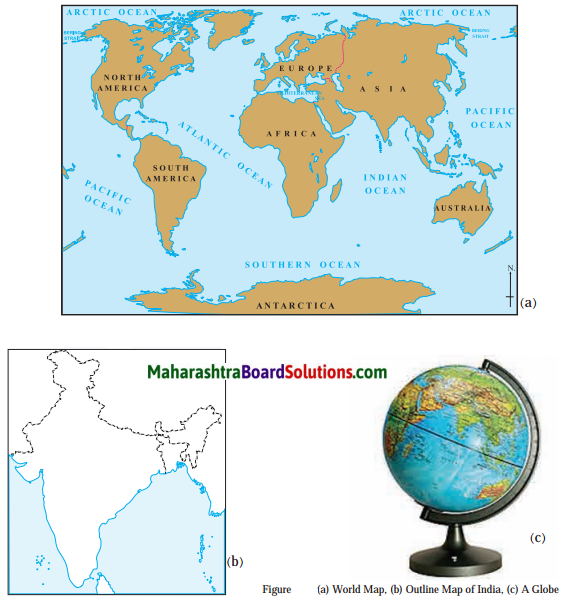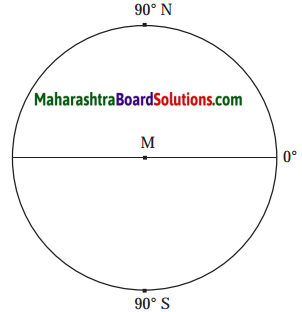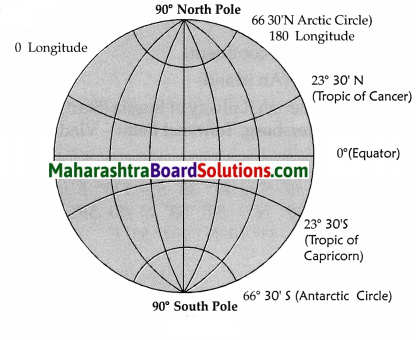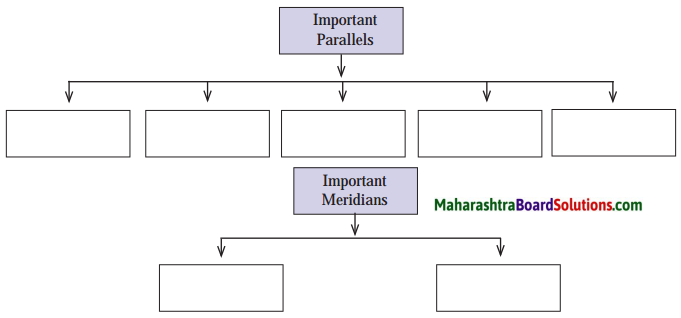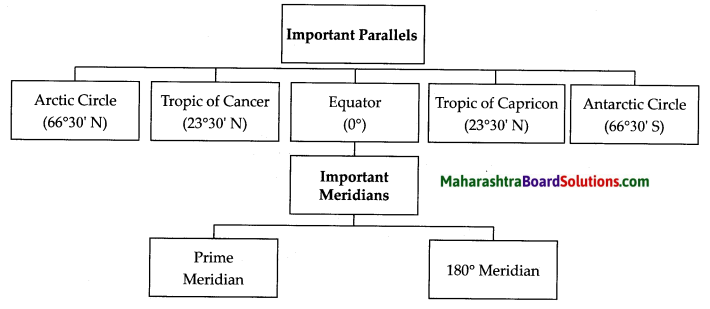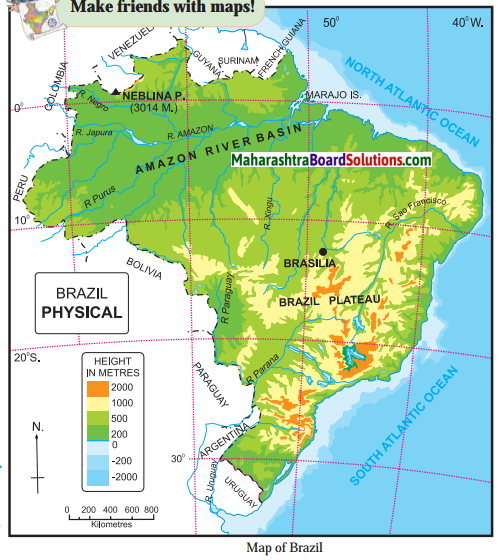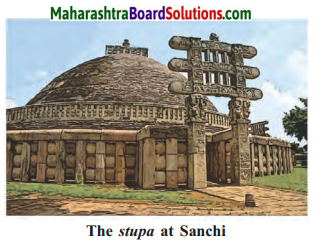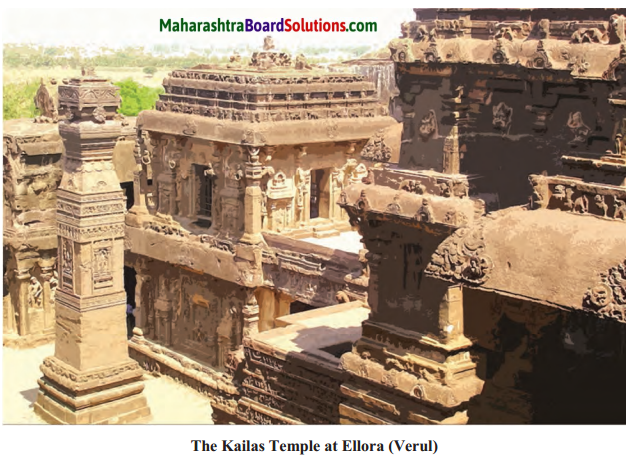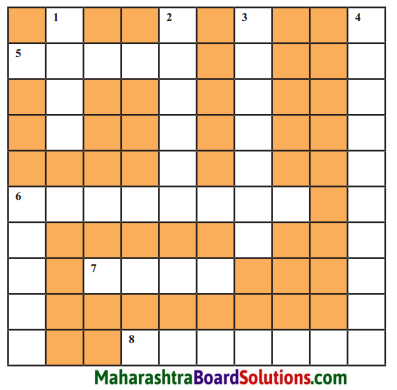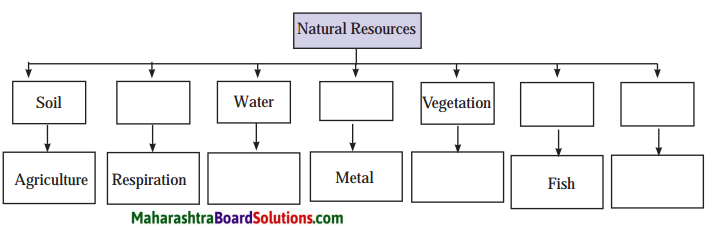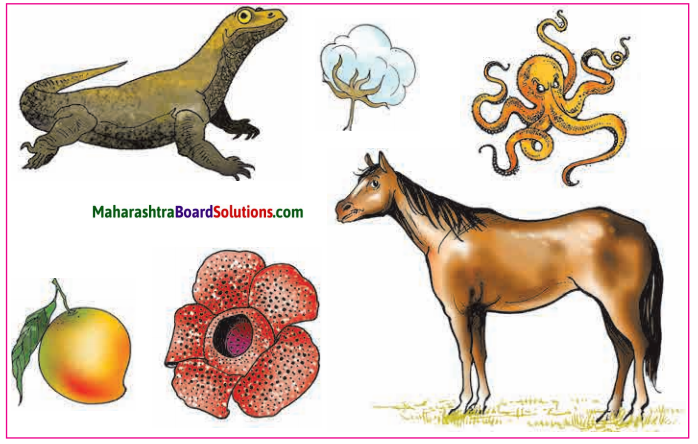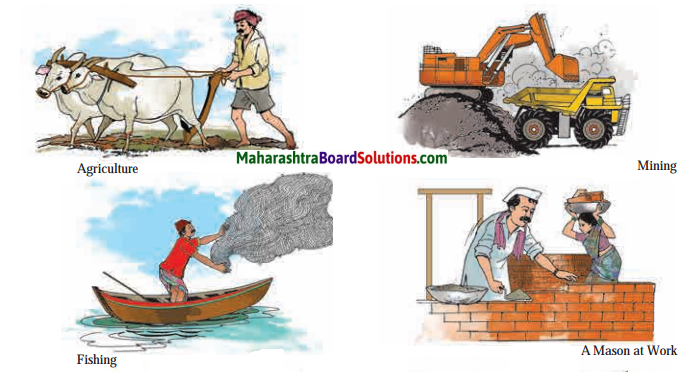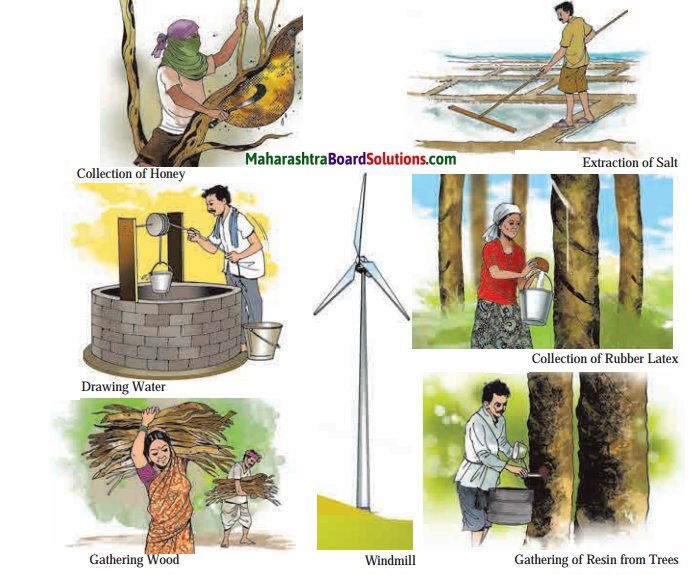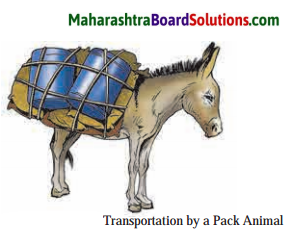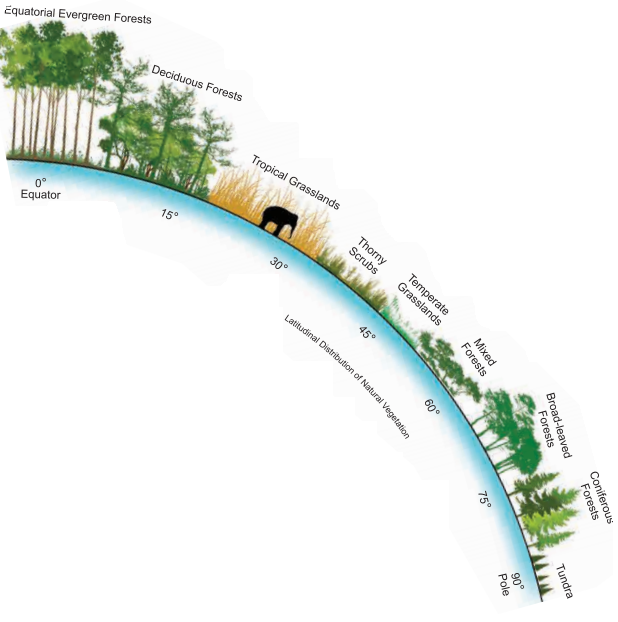Balbharti Maharashtra State Board Class 6 History Solutions Chapter 5 Religious Trends in Ancient India Notes, Textbook Exercise Important Questions and Answers.
Maharashtra Board Class 6 History Solutions Chapter 5 Religious Trends in Ancient India
Class 6 History Chapter 5 Religious Trends in Ancient India Textbook Questions and Answers
1. Fill in the blanks:
Question 1.
The principle of ______ is very important in Jainism.
(a) justice
(b) casteism
(c) non-violence
Answer:
(c) non-violence
Question 2.
An extraordinary feature of Gautam Buddha’s personality is his ______ for all living beings.
(a) compassion
(b) satisfaction
(c) anger
Answer:
(a) compassion
![]()
2. Answer in short:
Question 1.
What were the teachings of Vardhaman Mahavir?
Answer:
Vardhaman Mahavir taught the people that the greatness of man does not depend on his vama, but on his excellent conduct.
Question 2.
Which famous quotes of Gautam Buddha have you read here? What value does it uphold?
Answer:
- One of the famous quotes of Gautam Buddha is that ‘Even the little quail can chirp freely in her nest’, this quote depicts the values of freedom and equality of his preaching.
- Gautam Buddha preached that like men, women too had the right to their own upliftment.
Question 3.
What virtues are emphasized in Judaism?
Answer:
Judaism emphasizes justice, truth, peace, love, compassion, humility, charity, ethical speech and self-respect.
Question 4.
What are the teachings of Christianity?
Answer:
- According to the teachings of Christianity, we are all brothers and sisters.
- We should love everyone even our enemies.
- We should forgive those who err or go wrong.
![]()
Question 5.
What are the teachings of Islam?
Answer:
- The teachings of Islam is that Allah is eternal, absolute, all powerful and merciful.
- The purpose of human existence is to worship Allah.
- The Quran Sharif provides guidance as to how man should behave in life.
Question 6.
What is at the core of Parsee thinking?
Answer:
At the core of Parsee thinking are three main principles of conduct, namely, good thoughts, good words and good deeds.
3. Write notes on:
Question 1.
Aryasatya
Answer:
There are four truths at the root of all human affairs. They are called noble truths or Aryasatyas.
- Dukha (suffering): There is suffering in the world.
- The cause of suffering: There is a cause of suffering
- Dukkha – nivaran: It is possible to end suffering.
- Pratipad: Pratipad means the ‘way’ that leads to the end of suffering.
Question 2.
Panchasheel
Answer:
Gautam Buddha asked people to follow five rules called Panchasheel.
- Stay away from killing animals.
- Stay away from stealing.
- Stay away from unethical conduct.
- Stay away from telling lies.
- Stay away from intoxicants.
4. Put the following in the proper place in the chart of the Five Great Vows and the Three Jewels.
- Ahimsa
- Samyak Darshan
- Satya
- Asteya
- Samyak Jnan
- Aparigraha
- Samyak Charitra
- Brahmacharya
Answer:
| Five Great Vows | Three Jewels |
| (1) Ahimsa | (1) Samyak Darshan |
| (2) Satya | (2) Samyak Jnan |
| (3) Asteya | (3) Samyak Charitra |
| (4) Aparigraha | |
| (5) Brahmacharya |
![]()
5. Give reasons:
Question 1.
Why was the name ‘Jina’ given to Vardhaman Mahavir?
Answer:
Vardhaman Mahavir was called Jina or the Conqueror because the joy derived from physical comforts and the discomforts felt due to undesired things had no impact whatsoever on him.
Question 2.
Why did Gautam Buddha came to be called the Buddha?
Answer:
Gautam Buddha has attained knowledge of human life in its entirety. That is why he came to be known as the ‘Buddha’.
Activity:
- Collect the information about and the pictures of various festivals.
- Visit the prayer houses of different religions and describe the precincts in the classroom.
Class 6 History Chapter 5 Religious Trends in Ancient India Additional Important Questions and Answers
Complete the sentence by choosing the correct option:
Question 1.
Towards the end of the Vedic period, the minute details of yajna rites acquired ________ importance.
(a) undue
(b) least
(c) much needed
Answer:
(a) undue
Question 2.
A person’s social position was decided by the ______ into which he was born rather than by his achievements.
(a) ashrama
(b) varna
(c) Kula
Answer:
(b) varna
Question 3.
Jainism is one of the ancient _______ in India.
(a) topic
(b) religions
(c) civilization
Answer:
(b) religions
Question 4.
Vardhaman Mahavir is the _______ Tirthankar in the jain religious tradition.
(a) 24th
(b) 25th
(c) 26th
Answer:
(a) 24th
Question 5.
The principle of is very important in Jainism.
(a) justice
(b) casteism
(c) non-violence
Answer:
(c) non-violence
Question 6.
Vardhaman Mahavir was born in ________, a part of Vaishali.
(a) Kundagram
(b) Gaya
(c) Nepal
Answer:
(a) Kundagram
Question 7.
Vardhaman Mahavir left his house and all comforts for the attainment of ______.
(a) non-violence
(b) knowledge
(c) God
Answer:
(b) knowledge
![]()
Question 8.
He attained enlightenment after twelve and a half years of rigorous _______.
(a) tapa
(b) exercise
(c) good health
Answer:
(a) tapa
Question 9.
Vardhaman is said to be _______ because he had the resilience, the courage to conquer all passions.
(a) victorious
(b) saint
(c) Mahavir
Answer:
(c) Mahavir
Question 10.
The _______ held by the Tirthankar to preach to people was known as ‘samavasaran’.
(a) procession
(b) meeting
(c) assembly
Answer:
(c) assembly
Question 11.
Among the teachings of Mahavir, Anekantavada is considered to be very _____ in the quest for truth.
(a) honest
(b) important
(c) nice
Answer:
(b) important
Question 12.
In the Vedic tradition, the doors of knowledge had slowly been closed to ________.
(a) women
(b) men
(c) children
Answer:
(a) women
Question 13.
Gautam Buddha was the founder of ________.
(a) Christianity
(b) Buddhism
(c) Zoroastrianism
Answer:
(b) Buddhism
Question 14.
Gautam Buddha delivered his first sermon at _______ near Varanasi.
(a) Harappa
(b) Sarnath
(c) Lumbini
Answer:
(b) Sarnath
Question 15.
Pratipad means the ‘way’ that leads to the end of ________.
(a) suffering
(b) life
(c) preach
Answer:
(a) suffering
![]()
Question 16.
Gautam Buddha created a sangha of bhikkhus to ______ his religion.
(a) stretch
(b) reach
(c) preach
Answer:
(c) preach
Question 17.
People of all varnas and castes could _________ Buddhisms.
(a) reject
(b) embrace
(c) obey
Answer:
(b) embrace
Question 18.
An extraordinary feature of Gautam Buddha’s personality is his _______ for all living beings.
(a) compassion
(b) satisfaction
(c) anger
Answer:
(a) compassion
Question 19.
The tolerance preached by Gautam Buddha is a _____ principle not only for the Indian society but for all mankind even today.
(a) strict
(b) guiding
(c) aggressive
Answer:
(b) guiding
Question 20.
In the ancient period, new religious trends and thoughts went on ______ in India.
(a) emerging
(b) submerging
(c) revolting
Answer:
(a) emerging
Question 21.
Religions like Judaism, Christianity, Islam and Zoroastrianism also took ______ in the Indian society.
(a) stem
(b) branches
(c) root
Answer:
(c) root
![]()
Question 22.
A Jewish prayer house is known as ________.
(a) Temple
(b) Church
(c) Synagogue
Answer:
(c) Synagogue
Question 23.
_______ is a religion founded by Jesus Christ.
(a) Hinduism
(b) Christianity
(c) Judaism
Answer:
(b) Christianity
Question 24.
According to the teachings of Christianity there is only ______ God.
(a) three
(b) two
(c) one
Answer:
(c) one
Question 25.
The ________ is the holy book of Christianity.
(a) Geeta
(b) Bible
(c) Avesta
Answer:
(b) Bible
Question 26.
A Christian prayer house is known as ______.
(a) Synagogue
(b) Agyari
(c) Church
Answer:
(c) Church
Question 27.
The Quran Sharif provides guidance as to how a man should ______ in life.
(a) behave
(b) sing
(c) evolve
Answer:
(a) behave
Question 28.
Since ancient times there have been ______ relations between India and Arabia.
(a) friendly
(b) trade
(c) unfriendly
Answer:
(b) trade
Question 29.
The prayer house of ________ is known as a mosque or masjid.
(a) Christians
(b) Muslim
(c) Parsees
Answer:
(b) Muslim
Question 30.
The sacred text of the Parsee or Zoroastrians is the _______.
(a) Bible
(b) Quran
(c) Avesta
Answer:
(c) Avesta
![]()
Question 31.
The ______ came to India from the Pars or Fars province of Iran.
(a) Parsees
(b) Muslims
(c) Hindus
Answer:
(a) Parsees
Question 32.
Zarathushtra or Zoroaster was the _______ of the Parsees.
(a) priest
(b) founder
(c) follower
Answer:
Question 33.
_______ is the name of the Zoroastrian God.
(a) Allah
(b) Ahur Mazda
(c) Ram
Answer:
(b) Ahur Mazda
Question 34.
The elements of fire and water are very important in the _______ religion.
(a) Zoroastrian
(b) Judaism
(c) Hinduism
Answer:
(a) Zoroastrian
Question 35.
The sacred fire burns in the temples which is known as _______.
(a) Church
(b) Mosque
(c) Agyaris
Answer:
(c) Agyaris
![]()
Match the following:
Question 1.
| Column A | Column B |
| (1) Vardhaman Mahavir | (a) Buddhism |
| (2) Gautam Buddha | (b) Synagogue |
| (3) Jesus Christ | (c) Jainism |
| (4) Zoroastrianism | (d) Quran Sharif |
| (5) Judaism | (e) Christianity |
| (6) Islam | (f) Agyari |
Answer:
1 – c
2 – a
3 – e
4 – f
5 – b
6 – d
Answer the following in one sentence:
Question 1.
How was a person’s social position decided?
Answer:
In the latter vedic period, a person’s social position was decided by the vama into which he was bom rather than by his achievements.
Question 2.
What led to the establishment of new religions?
Answer:
Many people realized that every person is free to find ways of his own upliftment and this led to the establishment of new religions.
Question 3.
Where was Vardhaman Mahavir born?
Answer:
Vardhaman Mahavir was born in Kundagram, a part of Vaishali in the state of Bihar.
![]()
Question 4.
After how long did Vardhaman Mahavir attain enlightenment?
Answer:
Vardhaman Mahavir attained enlightenment after twelve and a half years of rigorous tapa.
Question 5.
What did Jainism lay stress on?
Answer:
Jainism laid great stress on good conduct.
Question 6.
How do we know that equality was practised in Jainism?
Answer:
The assembly held by the Tirthankar to preach to people (samavasaran) was based on equality. People of all varnas had entry to it, hence we know that equality was practised in Jainism.
Question 7.
What is Aparigraha?
Answer:
Man tends to accumulate property due to greed. Aparigraha means not hoarding or accumulating anything in this way.
Question 8.
State the quotes of Vardhaman Mahavir that lay emphasis on his teachings.
Answer:
‘Love all living things’, ‘Have mercy and compassion’, and ‘Live and let live’ are quotes that lay emphasis on his teachings.
Question 9.
Where was Gautam Buddha bom?
Answer:
Gautam Buddha was bom at Lumbini in Nepal.
Question 10.
Give the names of Gautam Buddha’s parents.
Answer:
Gautam Buddha’s father’s name was Shuddhodana and mother’s name was Mayadevi.
Question 11.
When did Gautam Buddha recieve enlightenment?
Answer:
On Vaishakha Purnima, when Gautam Buddha was sitting in deep meditation under a pipal tree at Uruvela, near the city of Gaya in Bihar, he attained ‘Bodhi’ – enlightenment or the highest knowledge.
Question 12.
Where did Gautam Buddha deliver his first sermon?
Answer:
Gautam Buddha delivered his first sermon at Samath near Vamasi.
![]()
Question 13.
In which language did Gautam Buddha preach?
Answer:
Gautam Buddha preached in the people’s language, Pali.
Question 14.
What does Pratipad mean?
Answer:
Pratipad means the ‘way’ that leads to the end of suffering.
Question 15.
What was extraordinary about Gautam Buddha’s personality?
Answer:
Compassion for all living beings was an extra ordinary feature of his personality.
Question 16.
Which religions took root in Indian society?
Answer:
Religions like Judaism, Christianity, Islam and Zoroastrianism took root in the Indian society.
Question 17.
What is a Jewish prayer house called?
Answer:
A Jewish prayer house is called a synagogue.
Question 18.
Who founded Christianity?
Answer:
Christianity is a religion founded by Jesus Christ.
Question 19.
What is the sacred book of the Christians called?
Answer:
The sacred book of the Christians is called ‘the Bible’.
Question 20.
What is the prayer house of the Christians called?
Answer:
The prayer house of the Christians is called ‘a Church’.
Question 21.
What is the holy book of Islam called?
Answer:
The holy book of Islam is called the Quran Sharif.
Question 22.
What is the prayer house of Islam called?
Answer:
The prayer house of Islam is known as a mosque or masjid.
Question 23.
What is the sacred text of Parsees called?
Answer:
The sacred text of the Parsees is the ‘Avesta’.
Question 24.
Why are the Zoroastrians called Parsees?
Answer:
The Zoroatrians came to India from the Pars or Fars province of Iran, therefore they are called as Parsees.
![]()
Question 25.
What is the name of the Zoroastrian God?
Answer:
The Zoroastrian god is called the ‘Ahur Mazda’.
Question 26.
What is the prayer house of the Zoroastrians called?
Answer:
The prayer house of the Zoroastrians is called the Agyari.
Answer in short:
Question 1.
State the principle of Tri-ratnas as taught by Vardhaman Mahavir.
Answer:
Tri-ratnas are the three jewels or the three principles taught by Vardhaman Mahavir.
- Samyak Darshan or Right faith.
- Samyak Jnati or Right knowledge.
- Samyak Charitra or Right conduct.
Question 2.
What is sangha?
Answer:
- Gautam Buddha created a sangha of Bhikkhus and Bhikkhunis to preach his religion.
- These followers where those who gave up their domestic life and entered the sangha.
- They travelled on foot like the Buddha to preach Dhamma to the people.
Question 3.
How did Gautam Buddha explain the concept of equality?
Answer:
- Gautam Buddha announced the freedom based on vama.
- He refused the discrimination based on vama.
- No one is greater or smaller by birth, says Buddha.
- He stressed that greatness depended on one’s behaviour or conduct.
Question 4.
Who came to spread Christianity to India?
Answer:
- St. Thomas, one of the twelve disciples of Christ, came to Kerala in the first century of the Christian era.
- He established a church at Pallayur in Trichur district in 52 CE.
Give reasons:
Question 1.
Why is Vardhaman said to be Mahavir?
Answer:
Vardhaman is said to be ‘Mahavir’ because he had the resilience, the courage to conquer all passions.
![]()
Question 2.
Why did Mahavir preach in Ardhamagadhi?
Answer:
Mahavir spoke in Ardhamagadhi, a people’s language, to make it easy for the people to understand his preachings.
Question 3.
Why is Buddha’s teachings termed as dhamma-chakka-pavattan?
Answer:
Buddha delivered his first sermon at Sarnath near Varanasi. His teaching in the first sermon are termed dhamma. He set in motion the wheel of dhamma in this sermon. Therefore this event is called dhamma – chakra.
